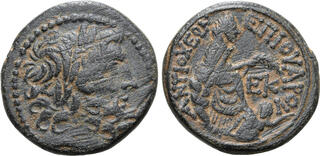Lot description:
Augustus Æ 20mm of Antioch, Seleucis and Pieria. Dated year 25 of the Actian Era = 7/6 BC. Pseudo-autonomous issue, struck under P. Quinctilius Varus, Governor of Syria. Laureate head of Zeus right / ΑΝΤΙΟΧΕΩΝ ΕΠΙ ΟΥΑΡΟΥ, Tyche seated to right on rocky outcropping, holding palm branch; EK (date) to right; at feet, half-length figure of river-god Orontes swimming right. RPC I 4252; BMC 59; McAlee 87. 6.19g, 20mm, 12h.
Very Fine; scratches.
The name of Publius Quinctilius Varus has become synonymous with the ignominious defeat suffered by Rome at the hands of Arminius and his confederation of German tribes in the Teutoburg forest. A son-in-law of the emperor, Varus had been consul in 13 BC (along with the future emperor Tiberius), governor of Syria, where he had sent two legions into Judaea to quell local unrest after the territory was converted to a Roman province, and subsequently governor of Germania. In AD 9, Augustus resolved to shorten Rome's borders by bringing the vast region of Germania across the Rhine under Roman dominion. Varus was tasked with negotiating a peaceful annexation, but the mixed Gauls and Germans of this land were not prepared to accept Roman overlordship. The Cherusci under Arminius, along with other allies, betrayed and ambushed Varus in the dank Teutoburg Forest of northwest Germany as the army marched in extended column, having neglected even to send out scouts. The so called 'Battle of the Teutoburg Forest' or in German, 'Varusschlacht', was fought over an extended area several kilometres long, resulting in the total annihilation of the XVII, XVIII and XIX Roman legions in a brutal series of ambushes that lasted for three days. Varus, sensing defeat, committed suicide, and when Augustus heard of the disaster, he rent his clothes and was seen to repeatedly butt his head against the wall of his palace, screaming 'Quintili Vare, legiones redde!' - 'Quinctilius Varus, give me back my legions!' Such was the magnitude of this disaster and the profound psychological shock it created, that the 17th, 18th and 19th legions were never reformed.
Estimate: 75 GBP |  |